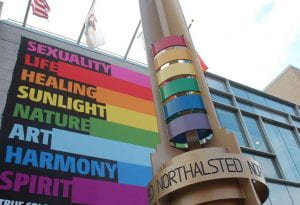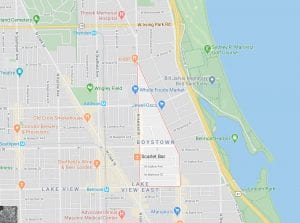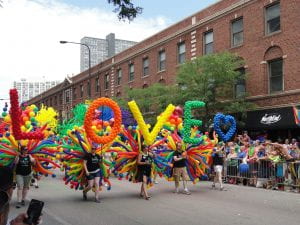Boystown: Understand inclusivity from multidimensions
Author: Cao Ruochen
Program of Study: Master of Arts Program in the Social Sciences (MAPSS), Division of the Social Sciences (SSD)
Located in the north part of Chicago, Boystown is one of the most renowned LGBTQ neighborhoods in the world. This spot has witnessed the Pride Parades every June for decades since the Stonewall Uprising in 1969. According to a local queer activist, Devlyn Camp, the nickname Boystown was given by columnist Rex Wockner from the Chicago newspaper Outlines, as a nod to the Father Flanagan’s group home for boys in the 1938 Spencer Tracy movie Boys Town (Camp, 2020). Nowadays, the Boystown neighborhood stretches roughly from Belmont Avenue up to Addison Street, and it spans from North Halsted Street to Broadway. Visitors can find various restaurants, gay bars, and clubs in this small yet dynamic cultural center.
While Boystown has played a crucial role in the LGBTQ community’s fight for legal equality and social acceptance, the formation of Boystown was due to persecution. During the 1960s, homosexuality was still considered as a crime and being gay meant discrimination in one’s personal life and workplace, and even being hospitalized. According to Tracy Baim, the co-founder, and publisher of Windy City Times, there once were gay areas dispersed across Chicago before the 1960s, yet the discrimination against them pushed individuals and businesses out to the northern side of the city. Gradually, medical clinics, gay community centers, and gay bars came and centered in the North Halsted area during the 1970s. As the area continued to attract gay businesses and residents, the street was developing into an LGBTQ identity within a few years.
As Jackson and Nargis of WBEZ radio noted, the turning point for the LGBTQ community came with the growing populations and property ownership of LGBTQ residents (Jackson, Nargis, 2017). LGBTQ residency and booming economic development by gay-related businesses in the North Halsted area helped cement the political clout of the LGBTQ community. In an article about gay and lesbian movement in Encyclopedia of Chicago, the author Carl Nash emphasized that Activist’s lobbying and demonstrations directly impelled the Chicago City Council to pass the Human Rights Ordinance in 1988, protecting lesbians, gays, and bisexuals from discrimination in housing, employment, and public accommodations (Nash, 2005). In 1997, Boystown was officially recognized as Chicago’s gay district. The city installed giant rainbow pillars in the area, which marked the very first time a big city bestowed recognition to a gay neighborhood.

Figure 2: Rainbow elements in the Boystown neighborhood. (Source: https://www.enjoyillinois.com/travel-illinois/lgbtq-chicago-boystown/)
Renaming Boystown
Despite prosperity in the human rights movements, there are some debates about inclusivity that still might be worth addressing. A petition started by Devlyn Camp on the website change.org is calling for Boystown to change to a gender-neutral name and has collected more than 1400 signatures. According to journalist Nara Schoenberg, although Boystown has been an iconic place for the LGBTQ community to advocate inclusivity and equality, there are certain groups that are feeling left out. In the article she wrote for the Chicago Tribune, Schoenberg indicated that there are long-lasting racism and sexism in the Boystown neighborhood against lesbian, transgender, and LGBTQ people of color (Schoenberg, 2020).
“The city’s problems with diversity are reflected in Boystown,” noted by Brier, the director of UIC’s gender and women’s studies program, in an interview with WBEZ radio. As we look back to history, it can be noticed that the history of Boystown is intertwined with the path of white gay people fighting for equal rights. Women or lesbians’ names hardly appeared in the narrative of Boystown’s history, and they are still told by gays that “this is not your neighborhood” (Schoenberg, 2020). African-American LGBTQ people have been suffering from racial segregation before the 1960s and they are still asked for multiple IDs when entering bars (Jackson, Nargis, 2017) and often denied jobs (Wittch, 2020). Inclusivity is not necessarily limited to gay people being accepted by the City of Chicago, as it is also vital to see the intersection of gender and race, and expend the notion of inclusivity to women, transgender, and LGBTQ people of color. Similarly, changing the name of Boystown is not necessarily guaranteeing that the sexism and racism will go away, yet taking the historical problems behind the name into account arouses people’s consideration of what inclusivity ought to be like.

Figure 3: People protesting in Boystown. (Source: https://www.advocate.com/business/2020/7/09/petition-demands-chicagos-boystown-change-name-be-more-inclusive/)
Shifting Demographics
While the local business leaders from Northalsted Business Alliance have begun the process of considering a name change by posting a survey online, the name has already left its mark in the neighborhood. As the name has been used as a marketing tool since the 1990s, the demographics of the neighborhood also have been changing rapidly. Boystown is becoming less of a place where gay people live and more of a gay entertainment district. On the one hand, vastly improved legal protections and cultural acceptance of the LGBTQ community means that the city is more inclusive for LGBTQ people to live in other areas. On the other hand, the decline in residency also suggests a falloff of the sense of a united community and self-identity as an LGBTQ center. As the way that LGBTQ people meet, interact, and build community is constantly being altered by the internet, the very need for a physical neighborhood is even being questioned by some members of the community.
Seemingly, the internet has created a broader virtual community for LGBTQ people to find allies easily, but it has also deepened the gap that has already existed. Results from the 2017 Youth Risk Behavior Survey show that 27 percent of LGBT youth have reported experienced cyberbullying, much higher as compared to their heterosexual peers (17.1 percent and 13.3 percent, respectively). The hatred and discrimination on the internet are no less than real life because technology won’t solve the problem but only magnify it. Regardless of the virtual community or real neighborhood, the problem is rooted in people’s understanding of inclusivity.
As the physical neighborhood of Boystown continues to serve as a cultural and commercial center for LGBTQ people in Chicago, there is another dimension of inclusivity that should not be overlooked. As the Journal of Alta California describes, homeownership and rental payments are financially untenable for many Americans in gay neighborhoods across the U.S., including Boystown (Downing, 2019). Results from the National Association of Gay & Lesbian Real Estate Professionals (NAGLREP) shows that 70 percent of LGBTQ renters indicated that not having enough money for a down payment is the biggest reason that they haven’t yet purchased a home (Berger, 2020). Socioeconomic status is often left unnoticed when people consider inclusivity, but it is the very factor that provides accessibility to a community and to acquire the related resources.
“If the neighborhood is going to continue as a viable and inclusive queer communal space, it will have to adapt,” Andie Meadows, a queer femme researcher, said to WBEZ radio. People are not naturally united only because of their gender identity or sexual orientation, there are other factors, political, socioeconomic, and cultural, that shape a person’s self-identity and awareness of otherness, as well as the Boystown neighborhood. Boystown will always be a substantial part of the legacy of Chicago, but its future will be determined on people’s understanding of inclusivity from more dimensions.
References
Berger, J. (2020, April 08). 2020 LGBT Real Estate Report. National Association of Gay & Lesbian Real Estate Professionals. Retrieved August 18, 2020, from https://naglrep.com/blog/2020/04/08/2020-lgbt-real-estate-report/
Camp, D. (2020, August 07). Why I’m Fighting to Take the “Boys” Out of Boystown. Them. Retrieved August 18, 2020, from https://www.them.us/story/boystown-chicago-name-change-petition-essay/amp
Downing, S. (2019, June 26). The Fight to Keep the Castro Queer. Alta Online. Retrieved August 18, 2020, from https://altaonline.com/protecting-the-gayborhood-from-gentrification-san-francisco-real-estate-castro-queer/
Jackson, S., & Nargis, J. (2017, May 7). Making Chicago’s Boystown. WBEZ [Radio program]. Retrieved August 18, 2020, from https://interactive.wbez.org/curiouscity/makingboystown/
Kann, L., McManus, T., Harris, W. A., Shanklin, S. L., Flint, K. H., Queen, B., Lowry, R., Chyen, D., Whittle, L., Thornton, J., Lim, C., Bradford, D., Yamakawa, Y., Leon, M., Brener, N., & Ethier, K. A. (2018). Youth Risk Behavior Surveillance – United States, 2017. Morbidity and mortality weekly report. Surveillance summaries, 67(8), 1–114. https://doi.org/10.15585/mmwr.ss6708a1
Nash, C. (2005). Gay and Lesbian Rights Movements. Encyclopedia of Chicago. Retrieved August 18, 2020, from http://www.encyclopedia.chicagohistory.org/pages/508.html
Schoenberg, N. (2020, July 11). Will Boystown become Rainbow Way? Local leaders consider a name change for Chicago’s signature gay neighborhood after a petition complains of sexism, racism and transphobia. Chicago Tribune. Retrieved August 18, 2020, from https://www.chicagotribune.com/lifestyles/ct-life-renaming-boystown-petition-07102020-20200710-wzfqwqshefa5tgh34kd7phxdgu-story.html
Wittich, J. (2020, June 22). T Rex, Leader In Chicago Drag Scene, Dropped By Roscoe’s And Berlin Amid Allegations Of Racism. Block Club Chicago. Retrieved August 18, 2020, from https://blockclubchicago.org/2020/06/22/t-rex-leader-in-chicago-drag-scene-dropped-by-roscoes-and-berlin-amid-allegations-of-racism/
3 Comments Already
Leave a Reply
You must be logged in to post a comment.


An interesting article!
Thank you!
Beautiful job Ruochen!